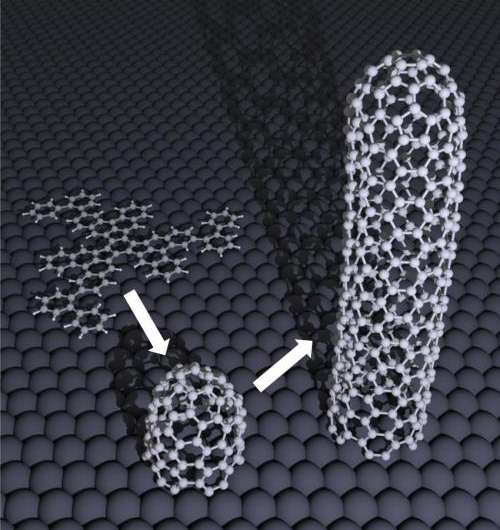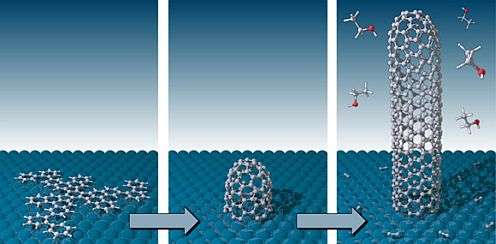August 7, 2014 report
Researchers develop method for growing single species of single-walled carbon nanotubes

(Phys.org) —A team of researchers with members from Switzerland and Germany has developed a method for producing a specific single-walled carbon nanotube type with a predefined structure. They describe the procedure in their paper published in the journal Nature. James Tour offers a News & Views piece in the same journal discussing the groundbreaking work done by the team.
Carbon nanotubes, as most are aware, are tubes made of only carbon atoms, and quite often have walls that are just one atom thick (known as single-walled). Because of their unique properties, researchers have been creating and using them in a variety of applications ranging from solar cells, to light detectors and sensors. One serious hindrance to their widespread use has been an inability to mass produce single-walled carbon nanotubes that are all nearly exactly alike. Growing them using conventional methods results in nanotubes that have a variety of different shapes and sizes, thus using them requires separating out the ones that fit specifications, a time consuming and expensive process. In this new effort, the research team has developed a way to produce a "batch" of nanotubes that all have the same characteristics.
Carbon nanotubes types are defined by species, each has what is known as a chirality index that consists of two numbers—one describes tube diameter, the other the angle of the walls relative to the base when the tube has been rolled up. To create nanotubes that are all alike in one go, would mean creating a batch that are all of the same species with the came chirality index. To make that happen, the team began with predefined "seeds"—organic molecules that were specifically created for the purpose, using a multistep process. The seeds were placed on a platinum surface and then the whole works was heated to 500° centigrade—ethanol was used as the source for the carbon atoms. As the researchers explain, it's the arrangement of the atoms in seeds that determines the species of the nanotubes that grow. In their experiments, they grew carbon nanotubes with a (6,6) chirality index.

The process is not without its problems, of course, the resulting nanotubes all come out standing upright, which tend to bundle as they grow longer—that could present problems for some processes. Also, the amount of material used for the base is significantly larger than for conventional methods adding extra cost. Despite these limitations, the achievement by the team is considered to be a major breakthrough in creating single-walled carbon nanotubes.



More information: Controlled synthesis of single-chirality carbon nanotubes, Nature 512, 61–64 (07 August 2014) DOI: 10.1038/nature13607
Abstract
Over the past two decades, single-walled carbon nanotubes (SWCNTs) have received much attention because their extraordinary properties are promising for numerous applications. Many of these properties depend sensitively on SWCNT structure, which is characterized by the chiral index (n,m) that denotes the length and orientation of the circumferential vector in the hexagonal carbon lattice. Electronic properties are particularly strongly affected, with subtle structural changes switching tubes from metallic to semiconducting with various bandgaps. Monodisperse 'single-chirality' (that is, with a single (n,m) index) SWCNTs are thus needed to fully exploit their technological potential. Controlled synthesis through catalyst engineering, end-cap engineering or cloning strategies, and also tube sorting based on chromatography, density-gradient centrifugation, electrophoresis and other techniques, have delivered SWCNT samples with narrow distributions of tube diameter and a large fraction of a predetermined tube type. But an effective pathway to truly monodisperse SWCNTs remains elusive. The use of template molecules to unambiguously dictate the diameter and chirality of the resulting nanotube holds great promise in this regard, but has hitherto had only limited practical success. Here we show that this bottom-up strategy can produce targeted nanotubes: we convert molecular precursors into ultrashort singly capped (6,6) 'armchair' nanotube seeds using surface-catalysed cyclodehydrogenation on a platinum (111) surface, and then elongate these during a subsequent growth phase to produce single-chirality and essentially defect-free SWCNTs with lengths up to a few hundred nanometres. We expect that our on-surface synthesis approach will provide a route to nanotube-based materials with highly optimized properties for applications such as light detectors, photovoltaics, field-effect transistors and sensors.
Journal information: Nature
© 2014 Phys.org



















